The AMD Trinity Review (A10-4600M): A New Hope
by Jarred Walton on May 15, 2012 12:00 AM ESTAMD Trinity Gaming Performance
After the 3DMark results, you might be wondering if Intel has finally caught up to AMD in terms of integrated graphics performance. The answer is…yes and no. Depending on the game, there are times where a fast Ivy Bridge CPU with HD 4000 will actually beat out Trinity; there are also times where Intel’s IGP really struggles to keep pace. The good news is that at least everyone is now onboard the DX11 bandwagon, and compatibility with games has improved yet again for Intel. Here are our “Value” benchmark results for seven recent games; we’ll have more information in a moment.

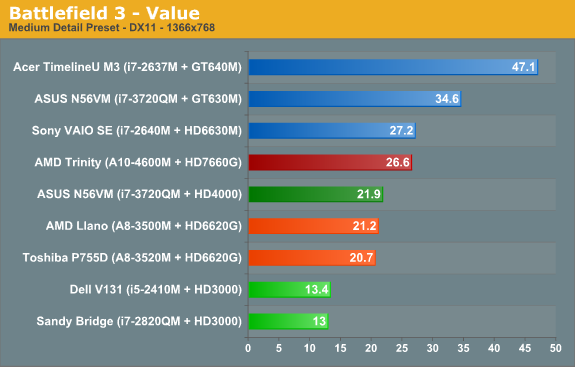
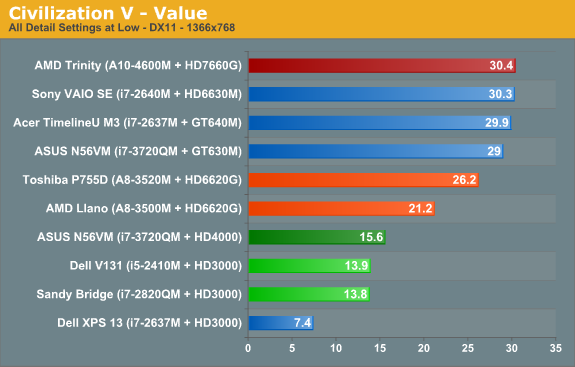

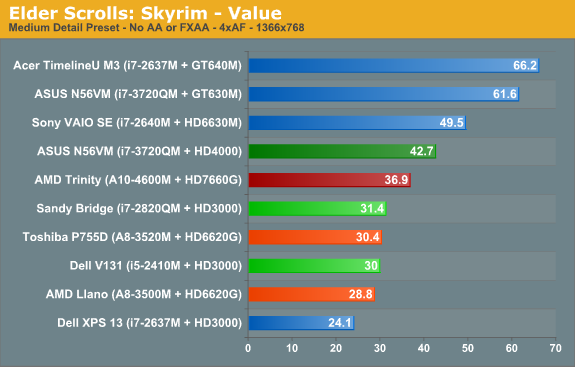
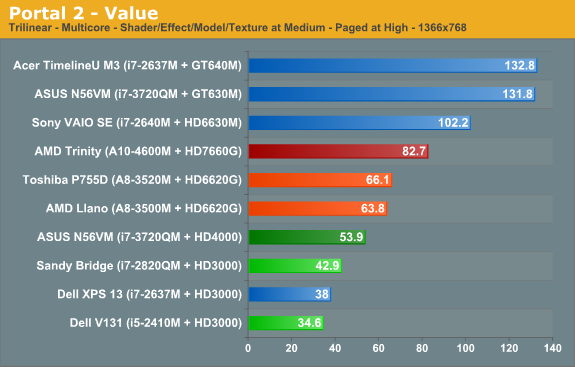
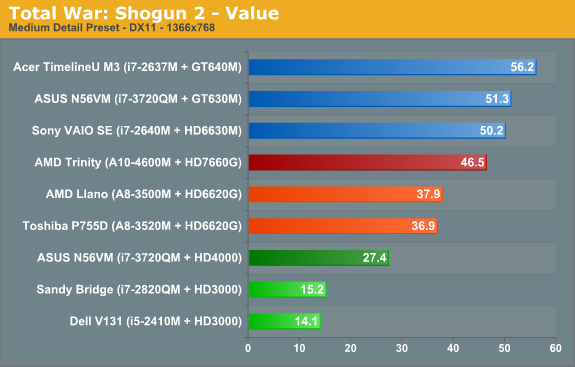
Out of our seven test titles, AMD’s Trinity leads any other IGP in four titles by a large margin. The other three titles actually have Ivy Bridge slightly ahead of Trinity, but the gaps aren’t nearly as big. Overall, the average performance across the seven games at our Value (medium) settings has AMD’s Trinity A10-4600M leading Intel’s i7-3720QM by 21%, and if we look at quad-core Sandy Bridge with HD 3000 (i7-2820QM) Trinity is 72% faster. Trinity is also around 20% faster than 35W Llano on average.
Let’s expand our gaming suite just a bit to see if things change, though. Just like we did with Ivy Bridge, we ran the eight games in our previous benchmark suite at medium detail settings. We can then compare performance across a wider 15 title selection to see how Trinity matches up against HD 4000, HD 3000, and HD 6620G (Llano). We’ll start with the bottom (HD 3000/Sandy Bridge) and move up.
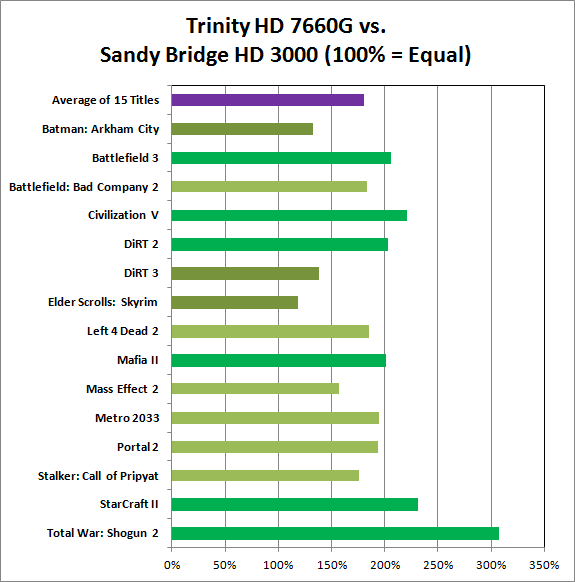
Llano’s HD 6620G was already faster than HD 3000, and Trinity’s HD 7660G is faster than Llano, so the Sandy Bridge gaming matchup is a landslide victory in AMD’s favor. The closest Intel can get is in the same three titles where Ivy Bridge leads Trinity: Batman: Arkham City, DiRT 3, and Skyrim. Here, however, HD 3000 can’t actually close the gap and HD 6620G is at least 20% faster than HD 3000, with an average performance improvement of nearly 80%.
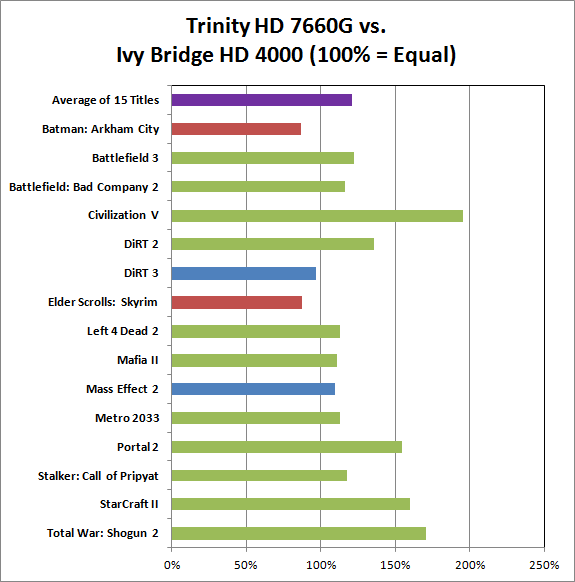
We found that across the same selection of 15 titles, Ivy Bridge and Llano actually ended up “tied”—Intel led in some games, AMD in others, but on average the two IGPs offered similar performance. This chart and the next chart will thus show a similar average increase in performance for Trinity, but the details in specific games are going to be different. Starting with Ivy Bridge and HD 4000, as with our earlier game charts we see there are some titles where Intel leads (Batman and Skyrim), a couple ties (DiRT 3 and Mass Effect 2), and the remainder of the games are faster on Trinity. Mafia II is close to our <10% “tie” range but comes in just above that mark, as do Left 4 Dead 2 and Metro 2033. The biggest gap is Civilization V, where Intel’s various IGPs have never managed good performance; Trinity is nearly twice as fast as Ivy Bridge in that title. Overall, it's a 20% lead for Trinity vs. quad-core Ivy Bridge.
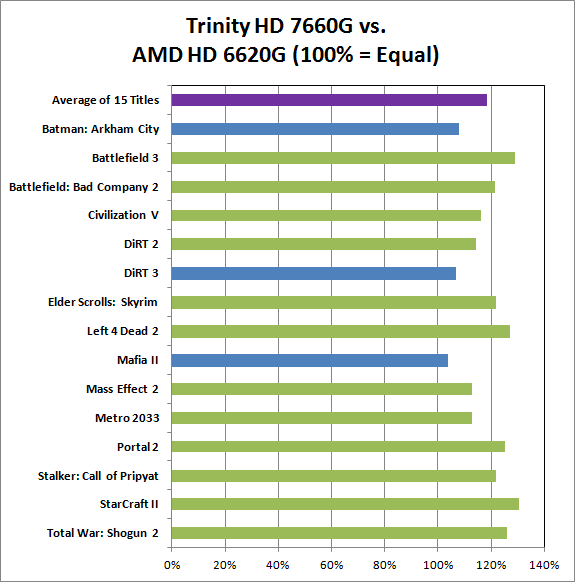
Against Llano, Trinity is universally faster, but the smallest gap is in Mafia II (3%) while the largest gap is in StarCraft II (30%). On average, looking at these games Trinity is only 18% faster than Llano. What’s not entirely clear from the above chart is whether we’re hitting CPU limitations, memory bandwidth limitations (remember that Llano and Trinity share bandwidth with the rest of the system), or perhaps both. At our chosen settings, what is clear is that Trinity’s “up to 56% faster” graphics never make it that high.
We saw 35-45% higher scores in 3DMark 11 and Vantage, which tend to remove the CPU from the equation more than actual games, so our guess would be that if AMD continues with their APU plan they’re going to need to work more on the CPU side of the equation. We also see the same thing looking at the VAIO SE scores in the earlier gaming charts: the HD 6630M scores are 20% faster on average, but much of that appears to come from the faster CPU rather than the GPU.










271 Comments
View All Comments
KompuKare - Tuesday, May 15, 2012 - link
What AMD really needs is a better IMC. Look at this recent computerbase article on IB and RAM:http://www.computerbase.de/artikel/arbeitsspeicher...
http://translate.google.co.uk/translate?hl=en&...
Unlike Llano IB doesn't perform a lot different as long it's running at DDR3-1600. Which to me says that Intel's IMC is a lot more efficient than AMD's. Ironic I know since AMD brought IMC to the x86 space, but the problem is that Intel have such a huge R&D budget compared to AMD.
I'll be interested in Jarred trying that review sample with DDr3-1333 too.
Assimilator87 - Tuesday, May 15, 2012 - link
A piece of my soul was crushed when I saw the HD 4000 ahead of Trinity. I don't care what the situation is, that should NEVER happen. 22nm and GCN can't come soon enough.ET - Tuesday, May 15, 2012 - link
While the HD 4000 still gets too low performance on occasion, I was generally impressed with it in this comparison. Intel GPUs have come a long way.As for Trinity, it looks like a well rounded solution. I'm more interested in the 17W version, as an alternative to Brazos. I like my Thinkpad x120e, and even run games on it occasionally, but it's still pretty weak.
ET - Tuesday, May 15, 2012 - link
"PCI Express support in Trinity remains at PCEe 2.0"althaz - Tuesday, May 15, 2012 - link
I'd pay $700 for an ultrabook-type laptop with this in it - provided it had a 128Gb Samsung SSD, a decent keyboard and an above-average screen.Ideally I'd like to get a convertible tablet with windows 8 on it powered by this. In laptop mode it's a portable gaming machine, in tablet mode a pretty nice tablet. Something 11.6"ish akin to the Transformer Prime from Asus in form factor
Riek - Tuesday, May 15, 2012 - link
Would it be possible to include power consumption (or batterly life) while gaming?Would it also be possible to add a cpu frequency - gpu frequency graph during some workloads? To see how turbo3.0 shapes up and how well the gpu turbo is implemented and used?
From my understanding gpu gets priority in turbo, but a trinity at 2.3GHz will just limit the performance in gaming. I wonder if the turbo is shaped up like that.
JarredWalton - Tuesday, May 15, 2012 - link
I noted battery life while looping 3DMark06 was 77 minutes. If we calculate power draw, that works out to around 43W. I also just checked AC power draw at the outlet during the same test, and the average power use was around 50W (45-55W range, but mostly right around 50). Accounting for AC adapter inefficiencies, if it's 80-85% efficient the laptop is using around 40-43W.Riek - Tuesday, May 15, 2012 - link
Yeah looked over that. So gaming wise llano is still a better option in regards to batterly life (alot better).Sandy bridge would be the worst choice. (as it gives the worst performance).
I'm suprised trinity and IvyB are so close in terms of 3dmark06 performance and battery life.
deathpony - Tuesday, May 15, 2012 - link
Hi, i have an AMD A6-3500http://valid.canardpc.com/show_oc.php?id=2369937
Gigabyte GA-A75M-UD2H
AMD Radeon HD 6530D
http://www.techpowerup.com/gpuz/63we6/
For some reason i was able to Undervolt the APU and push the clock to 2 Ghz while retaining stability. Also by raising the clock this much i got performance increase in double digits, can you test it out with Trinity? Thanks!
JarredWalton - Tuesday, May 15, 2012 - link
Unfortunately, the Trinity BIOS is pretty much useless as far as undervolting/overclocking/etc. are concerned. I'd be interested in testing such items, but we'd need a far more capable BIOS/motherboard than this laptop has.